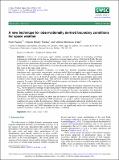Files in this item
A new technique for observationally derived boundary conditions for space weather
Item metadata
| dc.contributor.author | Pagano, Paolo | |
| dc.contributor.author | Mackay, Duncan Hendry | |
| dc.contributor.author | Yeates, Anthony Robinson | |
| dc.date.accessioned | 2018-05-01T14:30:07Z | |
| dc.date.available | 2018-05-01T14:30:07Z | |
| dc.date.issued | 2018-04-17 | |
| dc.identifier | 252974477 | |
| dc.identifier | cee481ce-a51c-4a1c-93cd-f86d1f9cb39f | |
| dc.identifier | 000430349800003 | |
| dc.identifier | 000430349800003 | |
| dc.identifier | 85087197983 | |
| dc.identifier.citation | Pagano , P , Mackay , D H & Yeates , A R 2018 , ' A new technique for observationally derived boundary conditions for space weather ' , Journal of Space Weather and Space Climate , vol. 8 , A26 , pp. 1-17 . https://doi.org/10.1051/swsc/2018012 | en |
| dc.identifier.issn | 2115-7251 | |
| dc.identifier.other | ORCID: /0000-0001-6065-8531/work/58055467 | |
| dc.identifier.uri | https://hdl.handle.net/10023/13271 | |
| dc.description | This research has received funding from the European Research Council (ERC) under the European Union’s Horizon 2020 research and innovation programme (grant agreement No 647214). D.H.M. would like to thank STFC and the Leverhulme Trust for their financial support. ARY was supported by STFC consortium grant ST/N000781/1 to the universities of Dundee and Durham. | en |
| dc.description.abstract | Context. In recent years, space weather research has focused on developing modelling techniques to predict the arrival time and properties of coronal mass ejections (CMEs) at the Earth. The aim of this paper is to propose a new modelling technique suitable for the next generation of Space Weather predictive tools that is both efficient and accurate. The aim of the new approach is to provide interplanetary space weather forecasting models with accurate time dependent boundary conditions of erupting magnetic flux ropes in the upper solar corona. Methods. To produce boundary conditions, we couple two different modelling techniques, MHD simulations and a quasi-static non-potential evolution model. Both are applied on a spatial domain that covers the entire solar surface, although they extend over a different radial distance. The non-potential model uses a time series of observed synoptic magnetograms to drive the non-potential quasi-static evolution of the coronal magnetic field. This allows us to follow the formation and loss of equilibrium of magnetic flux ropes. Following this a MHD simulation captures the dynamic evolution of the erupting flux rope, when it is ejected into interplanetary space. Results. The present paper focuses on the MHD simulations that follow the ejection of magnetic flux ropes to 4R⊙. We first propose a technique for specifying the pre-eruptive plasma properties in the corona. Next, time dependent MHD simulations describe the ejection of two magnetic flux ropes, that produce time dependent boundary conditions for the magnetic field and plasma at 4R⊙ that in future may be applied to interplanetary space weather prediction models. Conclusions. In the present paper, we show that the dual use of quasi-static non-potential magnetic field simulations and full time dependent MHD simulations can produce realistic inhomogeneous boundary conditions for space weather forecasting tools. Before a fully operational model can be produced there are a number of technical and scientific challenges that still need to be addressed. Nevertheless, we illustrate that coupling quasi-static and MHD simulations in this way can significantly reduce the computational time required to produce realistic space weather boundary conditions. | |
| dc.format.extent | 17 | |
| dc.format.extent | 4726473 | |
| dc.language.iso | eng | |
| dc.relation.ispartof | Journal of Space Weather and Space Climate | en |
| dc.subject | MHD | en |
| dc.subject | Solar Corona | en |
| dc.subject | CME | en |
| dc.subject | QB Astronomy | en |
| dc.subject | QA Mathematics | en |
| dc.subject | NDAS | en |
| dc.subject | BDC | en |
| dc.subject | R2C | en |
| dc.subject.lcc | QB | en |
| dc.subject.lcc | QA | en |
| dc.title | A new technique for observationally derived boundary conditions for space weather | en |
| dc.type | Journal article | en |
| dc.contributor.sponsor | European Research Council | en |
| dc.contributor.sponsor | Science & Technology Facilities Council | en |
| dc.contributor.sponsor | The Leverhulme Trust | en |
| dc.contributor.institution | University of St Andrews. Applied Mathematics | en |
| dc.identifier.doi | 10.1051/swsc/2018012 | |
| dc.description.status | Peer reviewed | en |
| dc.identifier.grantnumber | 647214 | en |
| dc.identifier.grantnumber | PO: 4070103637 | en |
| dc.identifier.grantnumber | RPG-305 | en |
This item appears in the following Collection(s)
Items in the St Andrews Research Repository are protected by copyright, with all rights reserved, unless otherwise indicated.

